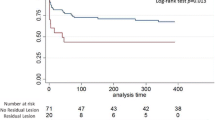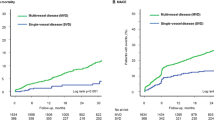Abstract
Although chronic total occlusion (CTO) in non-infarct-related arteries (non-IRAs) negatively affects long-term mortality in patients with acute myocardial infarction (AMI) who are undergoing primary percutaneous coronary intervention (PCI), the prognostic impact of successful CTO-PCI has not been completely addressed. Among 1855 consecutive patients with AMI who underwent primary PCI, those who were treated for CTO with either PCI or medical therapy were included. We evaluated the association between recanalization of CTO and long-term cardiac mortality. Of the 172 included patients, 88 underwent CTO-PCI, and the procedures were successful in 65 patients. Thus, the successfully recanalized CTO (SR-CTO) group included 65 patients; and the no recanalized CTO (NR-CTO) group, 107 patients. During the follow-up, 72 patients died, and of whom 56 (77.8%) died because of cardiac causes. The cumulative 10-year, 30-day, and 30-day to 10-year incidences of cardiac mortality were lower in the SR-CTO group than in the NR-CTO group (19.0% vs. 51.9% p = 0.004; 4.6% vs. 14.0%, p = 0.05; 15.0% vs. 44.1%, p = 0.003, respectively). After adjusting for confounding factors, the benefits of SR-CTO for the 10-year cardiac mortality remained significant compared with those of NR-CTO (hazard ratio 0.37; 95% confidence interval 0.17–0.75; p = 0.004). In conclusion, patients with SR-CTO in non-IRAs after AMI was associated with reduced long-term cardiac mortality compared with those with NR-CTO.



Similar content being viewed by others
References
Claessen BE, Dangas GD, Weisz G, Witzenbichler B, Guagliumi G, Mockel M, et al. Prognostic impact of a chronic total occlusion in a non-infarct-related artery in patients with ST-segment elevation myocardial infarction: 3-year results from the HORIZONS-AMI trial. Eur Heart J. 2012;33:768–75.
Claessen BE, van der Schaaf RJ, Verouden NJ, Stegenga NK, Engstrom AE, Sjauw KD, et al. Evaluation of the effect of a concurrent chronic total occlusion on long-term mortality and left ventricular function in patients after primary percutaneous coronary intervention. JACC Cardiovasc Interv. 2009;2:1128–34.
Hoebers LP, Vis MM, Claessen BE, van der Schaaf RJ, Kikkert WJ, Baan J Jr, et al. The impact of multivessel disease with and without a co-existing chronic total occlusion on short- and long-term mortality in ST-elevation myocardial infarction patients with and without cardiogenic shock. Eur J Heart Fail. 2013;15:425–32.
Choi IJ, Koh YS, Lim S, Choo EH, Kim JJ, Hwang BH, et al. Impact of percutaneous coronary intervention for chronic total occlusion in non-infarct-related arteries in patients with acute myocardial infarction (from the COREA-AMI Registry). Am J Cardiol. 2016;117:1039–46.
Shi G, He P, Liu Y, Lin Y, Yang X, Chen J, et al. Evaluation of the effect of concurrent chronic total occlusion and successful staged revascularization on long-term mortality in patients with ST-elevation myocardial infarction. Sci World J. 2014;2014:756080.
Yang ZK, Zhang RY, Hu J, Zhang Q, Ding FH, Shen WF. Impact of successful staged revascularization of a chronic total occlusion in the non-infarct-related artery on long-term outcome in patients with acute ST-segment elevation myocardial infarction. Int J Cardiol. 2013;165:76–9.
Elias J, van Dongen IM, Ramunddal T, Laanmets P, Eriksen E, Meuwissen M, et al. Long-term impact of chronic total occlusion recanalisation in patients with ST-elevation myocardial infarction. Heart. 2018;104:1432–8.
Henriques JP, Hoebers LP, Ramunddal T, Laanmets P, Eriksen E, Bax M, et al. Percutaneous intervention for concurrent chronic total occlusions in patients with STEMI: the EXPLORE trial. J Am Coll Cardiol. 2016;68:1622–32.
George S, Cockburn J, Clayton TC, Ludman P, Cotton J, Spratt J, et al. Long-term follow-up of elective chronic total coronary occlusion angioplasty: analysis from the U.K. Central Cardiac Audit Database. J Am Coll Cardiol. 2014;64:235–43.
Thygesen K, Alpert JS, Jaffe AS, Chaitman BR, Bax JJ, Morrow DA, et al. Fourth universal definition of myocardial infarction (2018). Eur Heart J. 2019;40:237–69.
Hoebers LP, Elias J, van Dongen IM, Ouweneel DM, Claessen BE, Piek JJ, et al. The impact of the location of a chronic total occlusion in a non-infarct-related artery on long-term mortality in ST-elevation myocardial infarction patients. EuroIntervention. 2016;12:423–30.
Bataille Y, Dery JP, Larose E, Dery U, Costerousse O, Rodes-Cabau J, et al. Prevalence, predictors and clinical impact of unique and multiple chronic total occlusion in non-infarct-related artery in patients presenting with ST-elevation myocardial infarction. Heart. 2012;98:1732–7.
Yang JH, Kim BS, Jang WJ, Ahn J, Park TK, Song YB, et al. Optimal medical therapy vs. percutaneous coronary intervention for patients with coronary chronic total occlusion—a propensity-matched analysis. Circ J. 2016;80:211–7.
Sianos G, Morel MA, Kappetein AP, Morice MC, Colombo A, Dawkins K, et al. The SYNTAX Score: an angiographic tool grading the complexity of coronary artery disease. EuroIntervention. 2005;1:219–27.
Khwaja A. KDIGO clinical practice guidelines for acute kidney injury. Nephron Clin Pract. 2012;120:c179–84.
Chesebro JH, Knatterud G, Roberts R, Borer J, Cohen LS, Dalen J, et al. Thrombolysis in Myocardial Infarction (TIMI) Trial, Phase I: a comparison between intravenous tissue plasminogen activator and intravenous streptokinase. Clinical findings through hospital discharge. Circulation. 1987;76:142–54.
Watanabe H, Morimoto T, Shiomi H, Furukawa Y, Nakagawa Y, Ando K, et al. Chronic total occlusion in a non-infarct-related artery is closely associated with increased five-year mortality in patients with ST-segment elevation acute myocardial infarction undergoing primary percutaneous coronary intervention (from the CREDO-Kyoto AMI registry). EuroIntervention. 2017;12:e1874–82.
Mehran R, Claessen BE, Godino C, Dangas GD, Obunai K, Kanwal S, et al. Long-term outcome of percutaneous coronary intervention for chronic total occlusions. JACC Cardiovasc Interv. 2011;4:952–61.
Morino Y, Abe M, Morimoto T, Kimura T, Hayashi Y, Muramatsu T, et al. Predicting successful guidewire crossing through chronic total occlusion of native coronary lesions within 30 minutes: the J-CTO (Multicenter CTO Registry in Japan) score as a difficulty grading and time assessment tool. JACC Cardiovasc Interv. 2011;4:213–21.
Ladwiniec A, Allgar V, Thackray S, Alamgir F, Hoye A. Medical therapy, percutaneous coronary intervention and prognosis in patients with chronic total occlusions. Heart. 2015;101:1907–14.
Ma Y, Li D, Li J, Li Y, Bai F, Qin F, et al. Percutaneous coronary intervention versus optimal medical therapy for patients with chronic total occlusion: a meta-analysis and systematic review. J Thorac Dis. 2018;10:2960–7.
Lee SW, Lee PH, Ahn JM, Park DW, Yun SC, Han S, et al. Randomized trial evaluating percutaneous coronary intervention for the treatment of chronic total occlusion. Circulation. 2019;139:1674–83.
Park S-J. DECISION-CTO. Optimal medical therapy with or without stenting for coronary chronic total occlusion. Annual meeting of the American College of Cardiology; May 18 2017; Paper Presented. Washington, DC. 2017.
Gershlick AH, Khan JN, Kelly DJ, Greenwood JP, Sasikaran T, Curzen N, et al. Randomized trial of complete versus lesion-only revascularization in patients undergoing primary percutaneous coronary intervention for STEMI and multivessel disease: the CvLPRIT trial. J Am Coll Cardiol. 2015;65:963–72.
Nombela-Franco L, Mitroi CD, Fernandez-Lozano I, Garcia-Touchard A, Toquero J, Castro-Urda V, et al. Ventricular arrhythmias among implantable cardioverter-defibrillator recipients for primary prevention: impact of chronic total coronary occlusion (VACTO Primary Study). Circ Arrhythm Electrophysiol. 2012;5:147–54.
O’Connor SA, Garot P, Sanguineti F, Hoebers LP, Unterseeh T, Benamer H, et al. Meta-analysis of the impact on mortality of noninfarct-related artery coronary chronic total occlusion in patients presenting with ST-segment elevation myocardial infarction. Am J Cardiol. 2015;116:8–14.
Allahwala UK, Ward MR, Bhindi R. Change in the distal vessel luminal diameter following chronic total occlusion revascularization. Cardiovasc Interv Ther. 2018;33:345–9.
Choo EH, Koh YS, Seo SM, Lee JM, Kim HY, Park HJ, et al. Comparison of successful percutaneous coronary intervention versus optimal medical therapy in patients with coronary chronic total occlusion. J Cardiol. 2019;73:156–62.
Patel VG, Brayton KM, Tamayo A, Mogabgab O, Michael TT, Lo N, et al. Angiographic success and procedural complications in patients undergoing percutaneous coronary chronic total occlusion interventions: a weighted meta-analysis of 18,061 patients from 65 studies. JACC Cardiovasc Interv. 2013;6:128–36.
Sapontis J, Salisbury AC, Yeh RW, Cohen DJ, Hirai T, Lombardi W, et al. Early pocedural and health status outcomes after chronic total occlusion angioplasty: a report from the OPEN-CTO registry (Outcomes, patient health status, and efficiency in chronic total occlusion hybrid procedures). JACC Cardiovasc Interv. 2017;10:1523–34.
Tajti P, Burke MN, Karmpaliotis D, Alaswad K, Werner GS, Azzalini L, et al. Update in the percutaneous management of coronary chronic total occlusions. JACC Cardiovasc Interv. 2018;11:615–25.
Suzuki Y, Tsuchikane E, Katoh O, Muramatsu T, Muto M, Kishi K, et al. Outcomes of percutaneous coronary interventions for chronic total occlusion performed by highly experienced Japanese specialists: the first report from the Japanese CTO-PCI expert registry. JACC Cardiovasc Interv. 2017;10:2144–54.
Morino Y, Kimura T, Hayashi Y, Muramatsu T, Ochiai M, Noguchi Y, et al. In-hospital outcomes of contemporary percutaneous coronary intervention in patients with chronic total occlusion insights from the J-CTO Registry (Multicenter CTO registry in Japan). JACC Cardiovasc Interv. 2010;3:143–51.
Takeuchi W, Habara M, Tsuchikane E, Suzuki T. The antegrade dissection and re-entry technique as preparation of intravascular ultrasound guided re-wiring. Cardiovasc Interv Ther. 2019. https://doi.org/10.1007/s12928-019-00572-2(Epub ahead of print).
Habara M, Tsuchikane E, Muramatsu T, Kashima Y, Okamura A, Mutoh M, et al. Comparison of percutaneous coronary intervention for chronic total occlusion outcome according to operator experience from the Japanese retrograde summit registry. Catheter Cardiovasc Interv. 2016;87:1027–35.
Yamamoto M, Tsuchikane E, Kagase A, Shimura T, Teramoto T, Kimura M, et al. Novel proctorship effectively teaches interventionists coronary artery chronic total occlusion lesions. Cardiovasc Revasc Med. 2018;19:407–12.
Shimura T, Yamamoto M, Tsuchikane E, Teramoto T, Kimura M, Satou H, et al. Safety of live case demonstrations in patients undergoing percutaneous coronary intervention for chronic total occlusion. Am J Cardiol. 2016;118:967–73.
Harding SA, Wu EB, Lo S, Lim ST, Ge L, Chen JY, et al. A new algorithm for crossing chronic total occlusions from the Asia Pacific Chronic Total Occlusion Club. JACC Cardiovasc Interv. 2017;10:2135–43.
Wu EB, Tsuchikane E, Ge L, Harding SA, Lo S, Lim ST, et al. Retrograde versus antegrade approach for coronary chronic total occlusion in an algorithm-driven contemporary Asia-Pacific multicenter registry: comparison of outcomes. Heart Lung Circ. 2019. https://doi.org/10.1016/j.hlc.2019.05.188(Epub ahead of print).
Acknowledgements
The authors thank Dr. Tatami for his help collect patient’s data.
Funding
This work was not supported by any funding.
Author information
Authors and Affiliations
Corresponding author
Ethics declarations
Conflict of interest
Department of Cardiology, Nagoya University Graduate School of Medicine received research Grant from Astellas Pharma Inc., Daiichi-Sankyo Co., Ltd., Dainippon Sumitomo Pharma Co., Ltd., Kowa Co., Ltd., MSD K. K., Mitsubishi Tanabe Pharma Co., Nippon Boehringer Ingelheim Co., Ltd., Pfizer Japan Inc., and Teijin Pharma Ltd. H. Ishii. received lecture fees from Astellas Pharma Inc., Bayer Pharmaceutical Co., Ltd., Daiichi-Sankyo Pharma Inc., and MSD K. K. T. Murohara received lecture fees from Bayer Yakuhin., Ltd., Daiichi-Sankyo Co., Ltd., MSD K. K., Mitsubishi Tanabe Pharma Co., Nippon Boehringer Ingelheim Co., Ltd. Other authors declare that they have no conflict of interest.
Ethical approval
All procedures performed in studies involving human participants were in accordance with the ethical standards of the institutional research committee and with the 1964 Helsinki declaration and its later amendments or comparable ethical standards.
Informed consent
Informed consent was obtained from all individual participants included in the study.
Additional information
Publisher's Note
Springer Nature remains neutral with regard to jurisdictional claims in published maps and institutional affiliations.
Electronic supplementary material
Below is the link to the electronic supplementary material.
12928_2019_615_MOESM1_ESM.pptx
The cause of all-cause mortality between the successfully recanalized chronic total occlusion (SR-CTO), and no recanalized CTO (NR-CTO) groups. Panels A and B shows the details of the all-cause mortality in patients who were classified into the SR-CTO-PCI, and NR-CTO groups. CHF, congestive heart failure; CAD, coronary artery disease; SCD, sudden cardiac death. (PPTX 72 kb)
Rights and permissions
About this article
Cite this article
Yoshida, R., Ishii, H., Morishima, I. et al. Prognostic impact of recanalizing chronic total occlusion in non-infarct related arteries on long-term clinical outcomes in acute myocardial infarction patients undergoing primary percutaneous coronary intervention. Cardiovasc Interv and Ther 35, 259–268 (2020). https://doi.org/10.1007/s12928-019-00615-8
Received:
Accepted:
Published:
Issue Date:
DOI: https://doi.org/10.1007/s12928-019-00615-8




